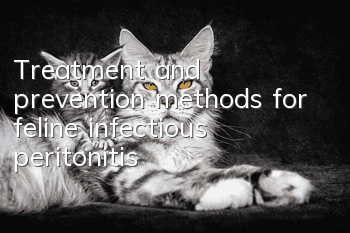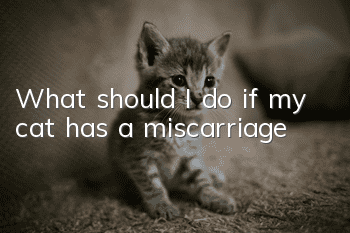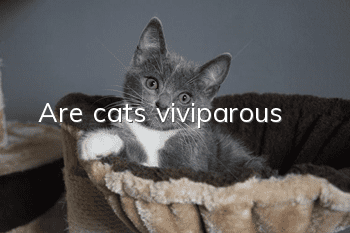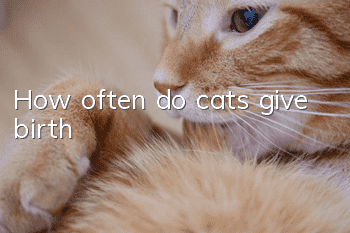Treatment and prevention methods for feline infectious peritonitis

Treatment methods: use high-dose steroids to suppress immunity and anti-inflammation, use broad-spectrum antibiotics to prevent secondary bacterial infections, force feeding, infusion to correct dehydration, and thoracentesis to relieve breathing; prevention and control methods: injection of vaccines, regular administration of serum For antibody testing, cats should be kept indoors as much as possible, and the litter box and environment should be cleaned every day.
Infectious peritonitis is a disease caused by infection with feline coronavirus, and the infection rate is very high. It is generally considered to be an infection through the mouth and nose. Cats that carry the virus will excrete the virus through their feces, and carrier cats will excrete the virus through their feces and infect cats living together; a few can be infected through mechanical means such as clothing, food dishes, bedding, people, or insects.
Treatment methods:
Regardless of the dry or wet type, symptoms such as intermittent fever and decreased appetite can occur. FIP is the most common infectious disease causing death in cats in recent years. Once it develops, the mortality rate is almost 100%. Moreover, there are practical difficulties in diagnosing feline infectious peritonitis (FIP). It is generally believed that only histopathological examination can 100% confirmed.
Immune suppression and anti-inflammatory effects: high-dose steroids, cytotoxic drugs.
Prevent secondary bacterial infections: broad-spectrum antibiotics and antiviral drugs.
Supportive therapy: forced feeding (esophageal or gastric tube), fluid infusion to correct dehydration, thoracentesis to relieve respiratory symptoms.
Prevention and control methods:
As the saying goes, prevention is better than cure; in addition to vaccines, management of the living and breeding environment and regular serum antibody testing are also important for the prevention of this disease. The vaccine is administered nasally to cats over 16 weeks of age, with two doses administered 3 to 4 weeks apart. No more than 8 to 10 cats should live in the entire area, and each group should be kept below 3 to 4 cats; try to keep them indoors, and keep the litter box and environment clean every day.
(1) Reduce the chance of fecal infection in the environment
1. A litter box can only be used by 1-2 cats at most.
2. The sand tray and surrounding environment need to be cleaned every day
3. After removing the cat litter from the litter box, it needs to be cleaned and disinfected with 1:32 times bleach or hot soapy water. 1%
4. The sand bowl and food bowl should be separated as much as possible and placed in a place that is easy to clean.
(2) Appropriate living environment and care
1. No more than 8-10 cats live in each area
2. Maintain less than 3-4 cats per group to reduce fecal interactionInfect.
3. Try to keep it indoors so that it can be well controlled. L-D
(3) Regularly perform serological antibody testing for FCoV
1. Because FECV can be converted into FIPV through genetic recombination or mutation, controlling FECV is as important as controlling FIP.
2.FCoV antibody detection cannot be used to diagnose FIP N4U
3.FCoV serological test results cannot be used as an indicator of whether environmental FIP has been completely eradicated
4. Before new elements join the cat group, it is best to separate FCoV-positive and FCoV-negative cats
5. Breeding female cats should undergo serological testing before giving birth. Positive female cats should be isolated when their kittens are 5-6 weeks old, that is, when the transitional antibodies decreaseG@
6. Although FCoV-positive cats are in a high-risk group for developing FIP, the incidence of FIP can be reduced by reducing stress factors and contact infection with feces. (4) Breeding farms in FCoV-endemic areas should wean kittens early and isolate them.
1. The kitten isolation room should be emptied out within a week and thoroughly cleaned and detoxified.
2. Female cats should be moved to the isolation delivery room 1-2 weeks before giving birth.
3. The kitten isolation room should have its own food bowl, water basin and sand basin, which should be thoroughly cleaned and detoxified.
4. Since cleanliness is the first priority in this area, in order to avoid man-made mechanical transmission, staff should change into exclusive clothes and shoes before entering.
(5) Vaccines
1. The vaccine currently on the market is Primucell FIP--Pfizer. Since the temperature at which the attenuated virus is most likely to reproduce is 31°C, which is exactly the temperature of the nasal cavity, this vaccine is administered through the nose to produce systemic mucosal antibody IgA. and humoral immune IgG to achieve protective efficacy. Suitable for cats over 16 weeks of age, administer two doses, 3-4 weeks apart.
2. Vaccination cannot be regarded as the only ultimate tool to control FIP, but should be used in other vaccination control programs.
3. The vaccine is recommended for new cat members before they join the FCoV epidemic area.
4. In cats with negative serological tests, the use of vaccines can reduce the incidence of FIP by 50-75%.
- Do cats with folded ears definitely get the disease?
- Can a cat never go out for the rest of its life?
- What should I do if my cat’s eyes are inflamed and can’t open? It may lead to blindness!
- What is the normal temperature of a cat’s body temperature?
- 20 kinds of food that cats can eat
- How to return a cat to normal after neutering
- What to do about cat depression
- What vaccines do cats need?
- There is white molting on the inside of the cat’s ears
- How to deal with skin diseases in kittens. First confirm the type of skin disease.



